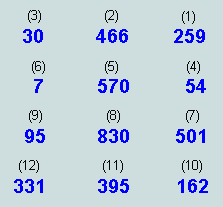
An Oracle Restored
One of the principal reasons for the 'Mt.Sinai encounter', recorded in Exodus 25-31, was to instruct Moses as to the precise details of construction of the portable sanctuary that would function as God's dwelling place on earth - the tabernacle - together with its furnishings, and manner of use.
Concerning the high-priestly vestments, we read particularly of the oracle - the Urim and Thummim (Ex.28:30) - provided for the guidance of the people in difficult and uncertain times. Details are lacking of the nature and use of these items(1), but we are informed that they were held in a pouch - called the breastplate (or, in some translations, breastpiece) - attached to the front of the ephod - the outmost garment of the high priest. This breastplate was formed from a single piece of highly-embroidered linen cloth one cubit long and half a cubit wide, folded over in two to form a square, half a cubit by half a cubit (about 9in.x 9in). It was adorned with twelve precious stones on which were engraved the names of the tribes - ie those of the sons and grandsons of Jacob arranged according to their order of birth. These were set out in four rows of three stones each (Ex.28:15-30) [Appendix 1].
[Link to website on the Tabernacle]
In Ian Mallett's paper The Breastplate of Judgment(2), attention is drawn to the many interesting features attending the matrix of integers formed from the characteristic values (hereafter "CVs") [Appendix 2] of the breastplate names:

2. The contiguous multiples of 37
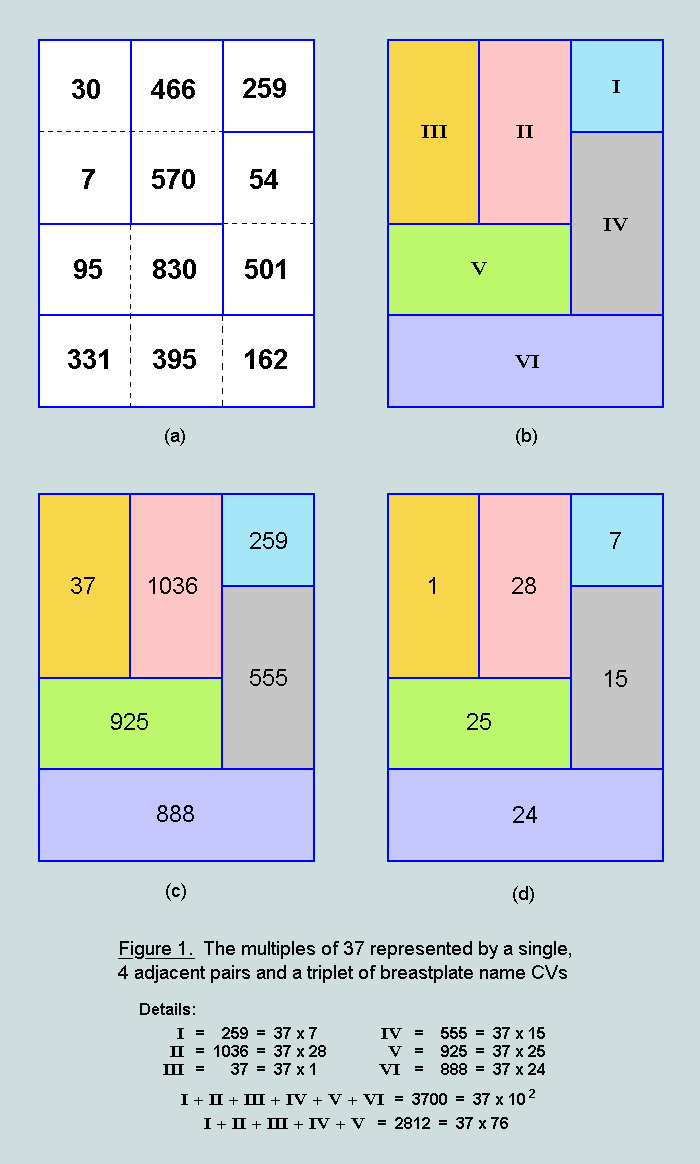
At (a), we have the breastplate matrix and observe that it may be divided into 6 regions, here designated I, II, III, IV, V and VI - as at (b) - such that the sum of the name CVs within each region is a multiple of the uniquely-symmetrical number 37 - as represented at (c) - the corresponding multipliers of 37 being depicted at (d).
We read in John's Gospel, "He was in the world, and the world was made by him, and the world knew him not." (ch.1, v.10). Remarkably, the breastplate is imprinted with our Creator's 'signature' - the bottom row (value 888) conveying the encoded name, 'Jesus', and the connected block above (value 1480), the title, 'Christ', thus:
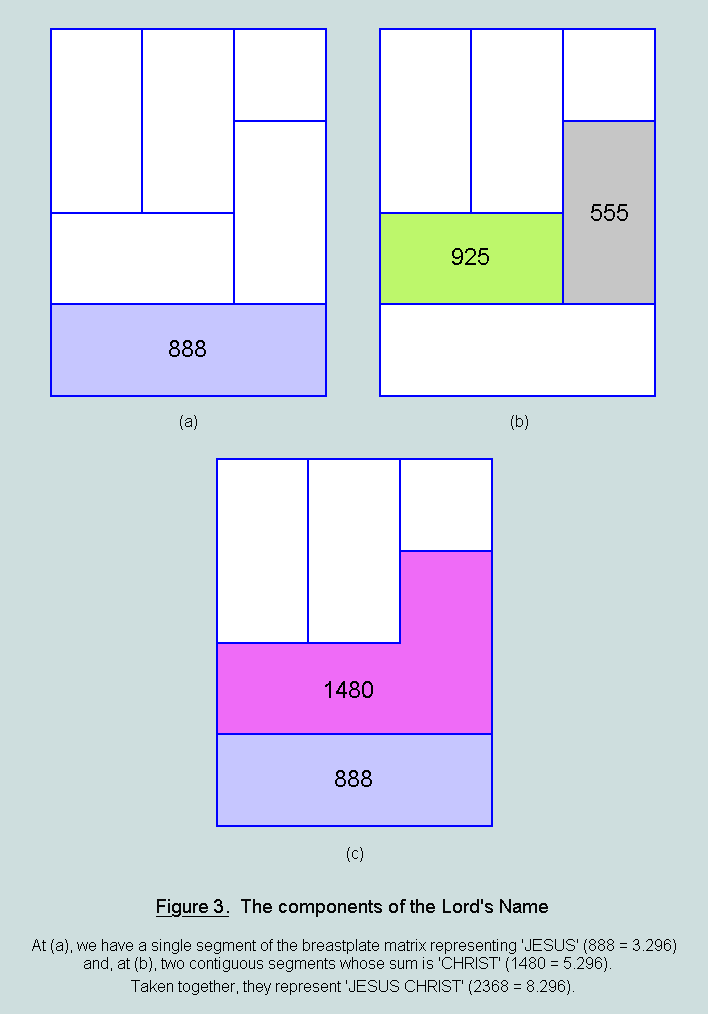
And we further observe powerful symbolism in the fact that the ratio, name:title, represented numerically by 888:1480, or 3:5, is identical with that of the sides of the mercy seat (Ex.25:17-22) - central element in tabernacle worship! [Details concerning the derivation of the characteristic values of the Creator's name and title are given in Appendix 3.]
The foregoing facts lead directly to a pythagorean view of the breastplate - one in which the Lord's Name plays an essential role.
As we have just seen, the breastplate matrix (value 100x37) may be divided into two blocks, thus:
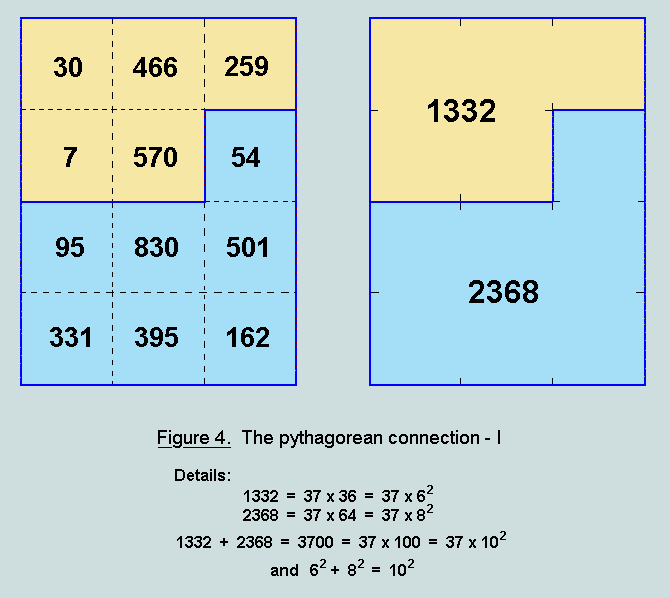
Here, it may be observed that the square roots of the multipliers of 37, {6,8,10} form a pythagorean triple that is a simple multiple of the classic case, {3,4,5}! Four such triangles are generated when a square of side 10 units is rotated by 36.87° (nearly 37°!) within a centred square of side 14 units, thus:
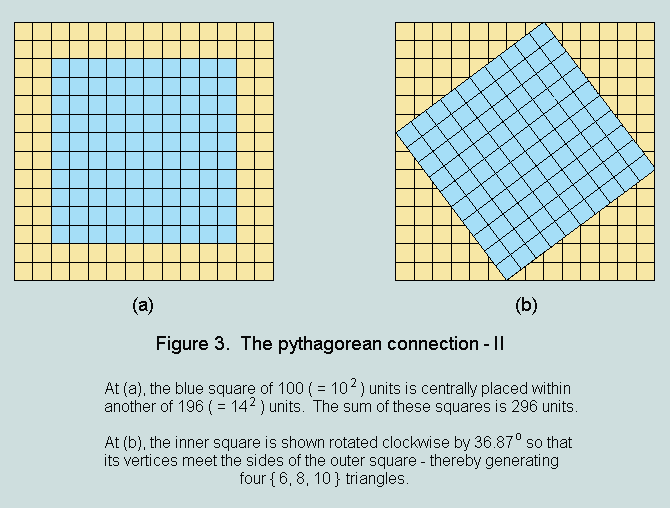
The sum of these squares is 296 - a number that has already been shown to be an essential feature of the breastplate.
It has already been observed that the sum of the odd-numbered names is precisely one half of the total, and therefore equal to the sum of the even numbered names. However, as revealed below, there is another arrangement which halves the structure numerically, and two which divide it in the ratio 1/4:3/4, thus:
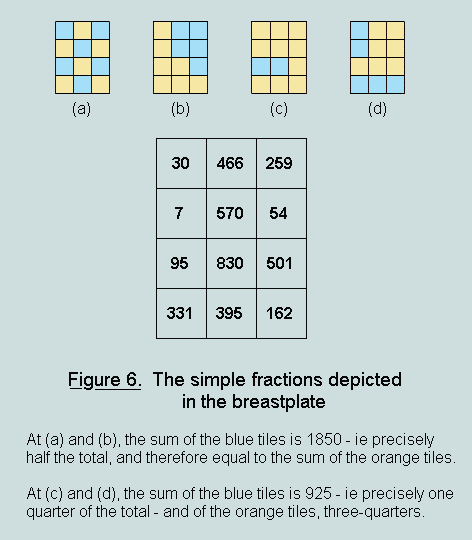
Further, in 925, we have the value of the Creator's name and title, as derived from the English analogue of the Hebrew alphabetic numbering scheme(5). A computer simulation reveals that about 5% of equivalent random sets exhibit these combined properties.
We observe that 7 of the 12 integers in the array exhibit interesting relationships of the form,
Multiple (M) / Divisor (D) = Quotient (Q)
Thus:
259 (the 1st) / 7 (the 6th) = 37
570 (the 5th) / 30 (the 3rd) = 19
162 (the 10th) / 54 (the 4th) = 3
570 (the 5th) / 95 (the 9th) = 6
The order of appearance of these elements in the matrix is as follows:
259 30 54 570 7 95 162
i.e. M D D M D D M
and we observe symmetry in the types represented, and between types, thus:
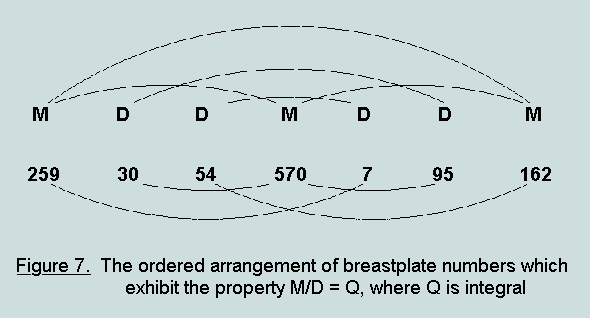
Further, an examination of the four quotients (Q) - 19, 3, 37, and 6 - reveals them to be significant and related figurate (6) numbers, thus:
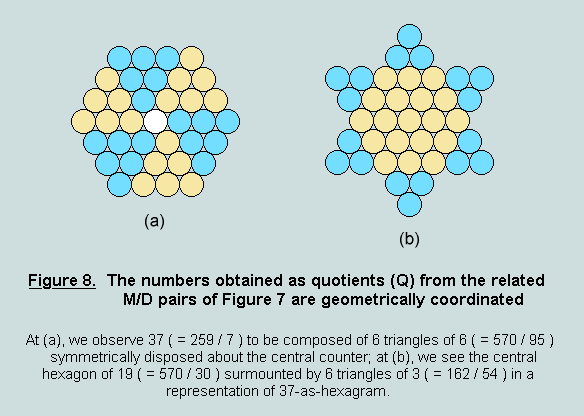
There are a number of points of contact between the numerical features of the breastplate, as outlined above, and those of the Hebrew Bible's first verse:
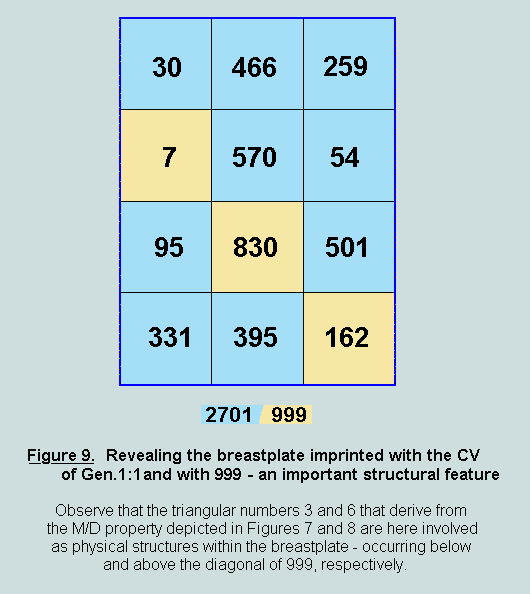
Clearly, they are the work of one supreme author!
As has been demonstrated in an earlier paper (8), 2368 and 2701 - symbols of the Creator and Creation, respectively - are also objects of considerable significance per se in the field of numerical geometry(9). Both exhibit compound symmetries which take the form of two-dimensional arrangements of uniform three-dimensional elements(10)
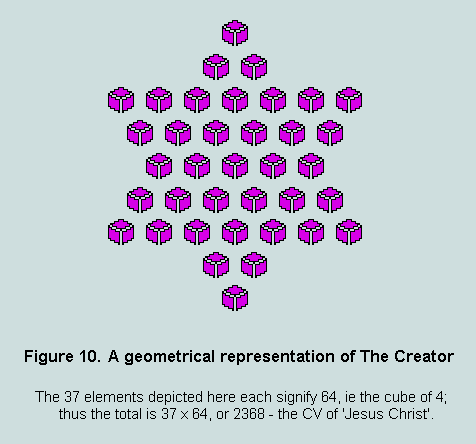 .
.
Here we observe 37 cubes - each of 64 units(11) - set out as a regular hexagram. Remarkably, the figure is harmonised by the fact that these cubes are represented in two-dimensions by numerical hexagons - each of 37 units(3)! The total represented is 37x64, or 2368 - the characteristic value (CV) of the Lord (Appendix 3).
In the next diagram, 2701, or 37x73 - the CV of Gen.1:1 - is depicted as a hexagram of 73 gnomons - each of 37 units(3).
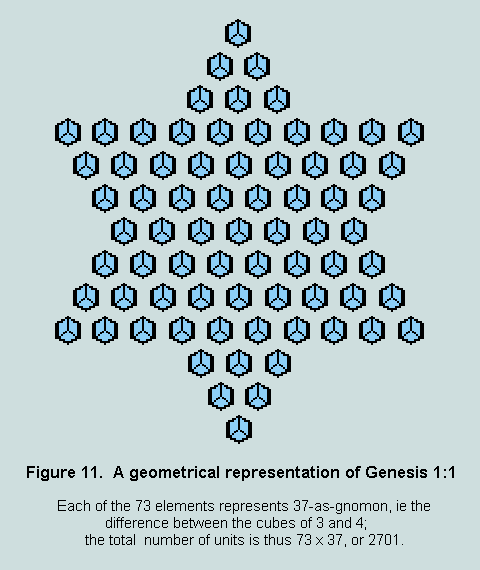
Figure 10 may now be centred and superimposed on Figure 11, thus:
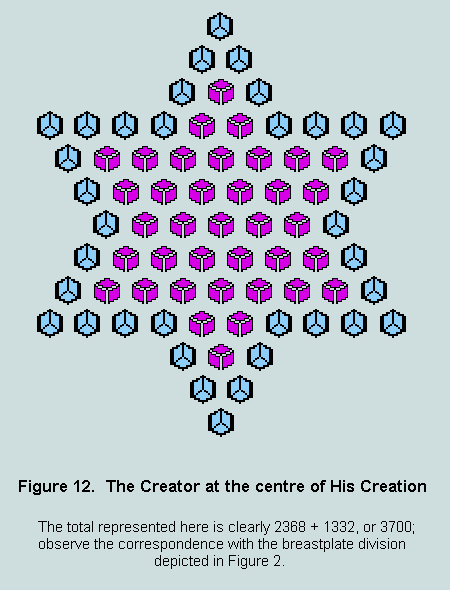
The 'halo' of 36 visible gnomons (blue) embodies 36x37, or 1332 units, and the total represented by the whole is thus 1332+2368, or 3700 units - the sum of the 12 breastplate names! However, it should not go unnoticed that the components of the total are to be found in a principal division of the breastplate matrix [Figure 2], and therefore participate in the pythagorean connection noted in Section 2! Further, the 24 gnomon elements underlying the outline of the central hexagram represent 24x37, or 888 units - the CV of 'Jesus' and bottom row of the matrix!
Alternatively, the last diagram may be perceived as the augmentation of Figure 11 by a hexagram of 37 smaller cubes - each of value 27 (i.e. 3^3). Clearly, the value represented by this hexagram would be 27x37, or 999. We observe that both 999 and 2701 are present in the breastplate - and form a significant division of it [Figure 9].
The fact that these constructions are hybrid - incorporating both two- and three-dimensional elements - is itself symbolic: it mirrors the dual nature of Jesus who was both perfect man and God!
Referring again to Figure 2 we observe that the division of the figure into two groups of 5 and 7 tiles, respectively, establishes further links with the Gen.1:1 phenomena. Thus we find that 37 is the arithmetic mean of 25 (= 5^2) and 49 (= 7^2) and, again, the centroid element(12) of the 73rd numerical triangle (an alternative representation of Gen.1:1(8)) is found to occupy the 25th position in the 49th row!
The phrase, I am
Alpha and Omega..., occurs three times in the text of the
Bible's last book (Rev.1:8, 21:6, 22:13) - its final appearance
being followed by the words, ...the beginning and the end, the
first and the last. It is the Lord Jesus Christ who is making
the amazing claim that all things are from him and for him!(13) In the original Greek this
significant phrase is rather peculiarly expressed each time it
appears, thus: whereas the first letter of the alphabet, Alpha,
is given by name ('![]() '),
the last, Omega, is given only as a symbol ('
'),
the last, Omega, is given only as a symbol ('![]() ')!(14) The matter appears to have been
designed to attract the attention of the careful reader. But to
what purpose?
')!(14) The matter appears to have been
designed to attract the attention of the careful reader. But to
what purpose?
Consulting Appendix 3, we observe the following numerical implications of this arrangement:
CV(![]() ) = 532; CV(
) = 532; CV(![]() ) = 800; their sum = 1332
= 36 x 37
) = 800; their sum = 1332
= 36 x 37
The more obvious expressions of the phrase would have involved either the names, or the symbols, of both letters, with the following numerical implications:
CV(![]() ) = 532; CV(
) = 532; CV(![]() ) = 849; their sum = 1381
= a prime number
) = 849; their sum = 1381
= a prime number
CV(A) = 1; CV(![]() ) =
800; their sum = 801 = 3 x 3 x 89
) =
800; their sum = 801 = 3 x 3 x 89
and the final possibility of symbol followed by name:
CV(A) =
1; CV(![]() ) = 849; their
sum = 850 = 2 x 5 x 5 x 17
) = 849; their
sum = 850 = 2 x 5 x 5 x 17
Clearly, the only arrangement to yield a multiple of 37 is precisely that found in the text! - and we observe that the particular multiple, 1332 - representing 'Alpha and Omega' - is that which not only accompanies 2368 ('The Lord') in the breastplate matrix [Figure 2] but also functions as the outline hexagram ('the halo') in the representation of 'The Lord of Creation' [Figure 11(c)]!!
Again, in the context of the first verse of the Bible (Gen.1:1) - that 'treasure-trove' of numerical geometry (7)(8) - we find a similar association: the central Hebrew word is formed from the first and the last letters of the alphabet; immediately preceding it is 'Elohim', meaning 'God' - the Creator!
It seems abundantly obvious, therefore, that He who created all things and designed the breastplate is also the One who inspired the writing of the Book of Revelation!
email: vernon.jenkins@virgin.net
Link to Double Indemnity
This page was last modified 2006-03-11.
(1) The Urim and Thummim were clearly more than the equivalent of a pair of dice (as some have contended) for God did not always provide an answer (1Sam.14:36-37, 28:6). The response came either by a voice from heaven or by an impulse upon the mind of the high priest. This oracle was of great use to Israel (e.g. Nu.27:21, 1Sam.23:6-12).
(2) Obtainable from PALMONI RESEARCH, 4 Tynesdale, Whitby, Ellesmere Port, CH65 6RB, U.K.
(3) As an integer, thirty-seven has unique geometrical properties: 37 uniform squares or circles (as appropriate) can be arranged to fill any one of three symmetrical frames - octagon, hexagon, or hexagram; in hexagon form, it represents a typical 2D view of a cube of dimension 4, i.e. a stack of 64 unit cubes; it is also the difference between the cubes of 4 and 3. These features are illustrated in the following diagrams:
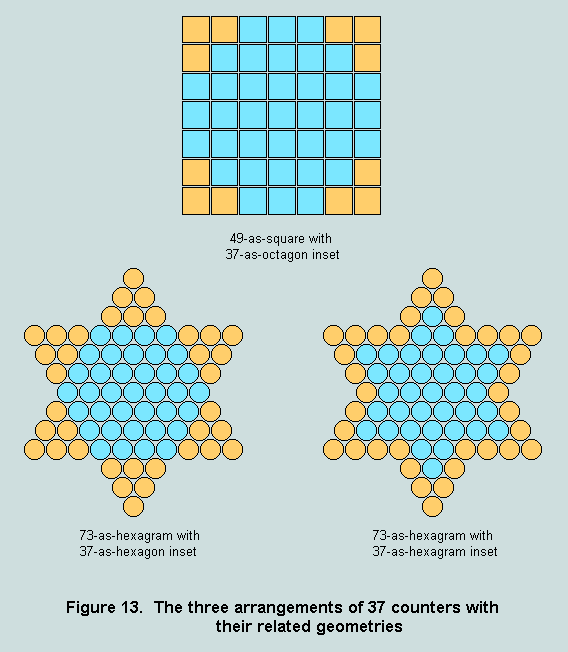
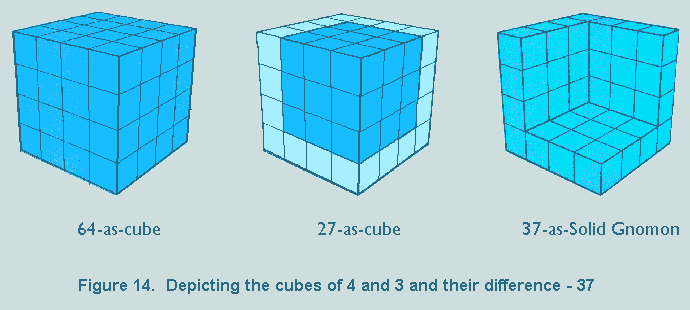
Clearly, 37 is associated with 16 axes of symmetry, and in this sense it is the most symmetrical of all numbers. But, in addition, as a denary object, it provides a basis for many interesting mathematical recreations (see The Ultimate Assertion: Evidence of Supernatural Design in the Divine Prologue, CEN Tech.J., vol.7(2), 1993, Appendix, pp.192-196).
(4) This appears significant since the breastplate was itself a square, and 10 is a highly significant number: a prominent feature of human anatomy, principal radix of man's number systems from the beginning, and collective unit in the now near universal principles of decimalisation and metrication.
(5) In Appendix 2, an outline is provided of the historically-attested Hebrew alphabetic numbering scheme. If the Roman alphabet is superimposed on this, and the values 500, 600, 700, and 800, assigned to the extra four letters W, X, Y, and Z, we then have a modern equivalent of this ancient scheme. Under this regime, the name 'JESUS' would assume the value 515 (i.e. 10+5+100+300+100), and the title 'CHRIST', 410 (i.e. 3+8+90+9+100+200); 'JESUS CHRIST' would therefore become 925, or 5^2x37.
(6) In the context of this page a figurate number is one which, when represented as a set of uniform circular or spherical counters, completely fills a polygonal or polyhedral frame. Examples are illustrated above.
(7) Such data are presented in the The Beginning of Wonders and in a number of printed documents, including The Ultimate Assertion: Evidence of Supernatural Design in the Divine Prologue. Please email the author for details.
(8) See for example The Arbiters of Truth
(9) Numerical geometry describes the study of those two- and three-dimensional structures that involve both number and form, i.e. the figurate numbers. These lie close to the heart of mathematics, and the symmetries represented are absolute in the sense that they are independent of radix, of time, and of place.
(10) Here, the 4th solid gnomon (= 37, difference between the 4th and the 3rd cubes) and the 4th cube (= 64 units) are symbolically represented by
![]()
(11) The 'units' referred to in this account are the unit cubes which function as counters in the construction of the diagrams.
(12) One in every three numerical triangles is built around a single counter which then functions as the centroid element - i.e. that which is equidistant from each of the three sides. Such a triangle is the 73rd.
(13) See also Colossians 1:16
(14) The writer is indebted to Captain Richard Prendergast for drawing his attention to this interesting anomaly.
Jacob fathered 12 sons by four women: his wives, Leah and Rachel; and his concubines - maidservants of Leah and Rachel - and surrogate mothers, Zilpah and Bilhah (Gen.29:31-35; 30:1-24; 35:16-18). The following table lists the names of the sons, in order of birth, with their respective mothers.
| 1. | REUBEN | Leah |
| 2. | SIMEON | Leah |
| 3. | LEVI | Leah |
| 4. | JUDAH | Leah |
| 5. | DAN | Rachel/Bilhah |
| 6. | NAPHTALI | Rachel/Bilhah |
| 7. | GAD | Leah/Zilpah |
| 8. | ASHER | Leah/Zilpah |
| 9. | ISSACHAR | Leah |
| 10. | ZEBULUN | Leah |
| 11. | JOSEPH | Rachel |
| 12. | BENJAMIN | Rachel |
Jacob's favorite son, Joseph, sold into slavery through the treachery of his elder brothers, ultimately became Pharaoh's 'right-hand man', married an Egyptian, and fathered two sons, MANASSEH and EPHRAIM (Gen.41:50-52). These two particular grandsons of Jacob were destined to become proxies for their father in the above list. The tribes - now numbering 13, and each identified by the name of its progenitor - remained in Egypt for some 400 years. Following the Exodus, and before entering the 'promised land', a significant event took place: at God's command, the sons of Levi were set apart and dedicated to His service; in due course, they would therefore not feature in the apportionment of the land between the tribes (Deut.10:8-9). Accordingly, we deduce that the name of Levi would not appear on the breastplate, for the high priest who bore it would himself have been of that tribe; again, as we have seen, Joseph would have been represented by his two sons. A reading of Nu.1 confirms these facts.
Many centuries after these events occurred, it became the practice to use Hebrew letters as numerals. All written words and names have since become fairly interpretable as numbers. Details of the Hebrew alphabetic numbering scheme are given in Appendix 2. The names of the tribes of Israel (assuming it is these that were engraved on the jewels of the breastplate), in progenitor birth order, and with their full numerical interpretations, are listed in the table below along with their Strong's reference number bracketed. [Note: to verify these Hebrew spellings you may access www.blueletterbible.org using the relevant reference number.]
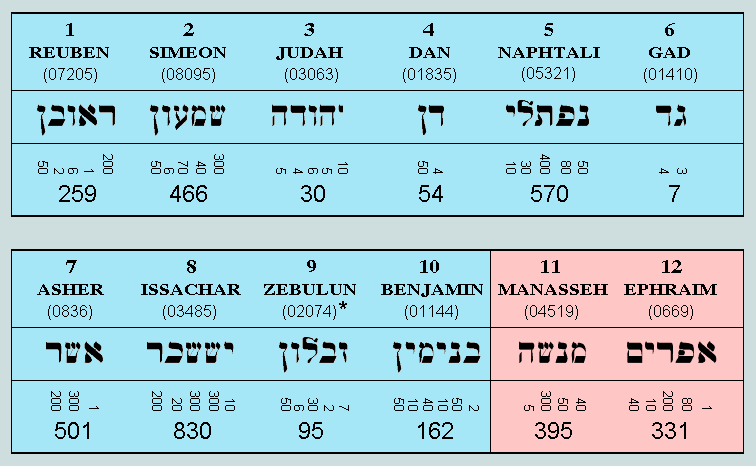
* In contrast to the other 11, the Hebrew rendering of the name Zebulun occurs in different ways - as detailed below:
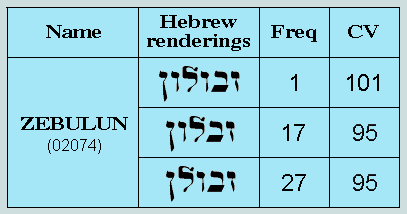
Observe that the column headed 'Freq(uency)' records the number of times each variation occurs in the Old Testament text; and that headed 'CV', the numerical values to be associated with these. For the purposes of the current exercise, it is clear that latter may be read either as 101 or 95. However, the latter is preferred here because, (a) it relates to the most frequent of the variations, (b) it is this value that raises the total of the 'Tribes of Israel' to a significant multiple of 37, and the one which establishes many of the internal breastplate characteristics.
It is worth noting that this layout corresponds with the engravings on the two onyx stones mounted on the shoulderpieces of the ephod (Ex.28:9-12).
The following diagrams present a summary of the matters discussed above.
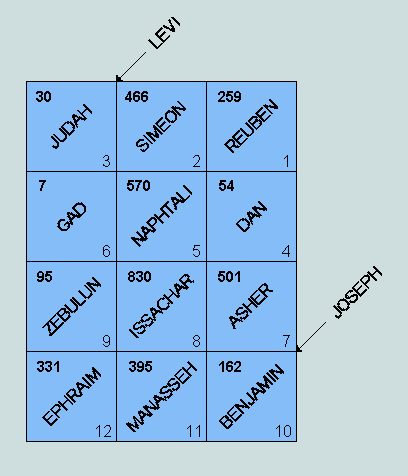
The breastplate is here represented as a tiled rectangle - the tiles being numbered from right to left, in the Hebrew manner - with the omitted names, Levi and Joseph, shown in their proper positions, by order of birth.
Here, finally, is the breastplate prepared for analysis as a 4 x 3 matrix of name CVs:
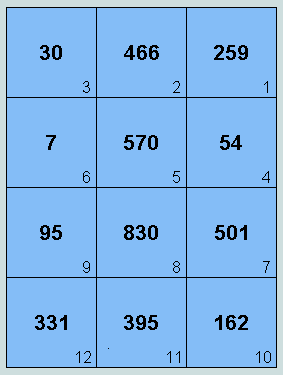
The Hebrew alphabet has 22 letters - five with 'end forms', i.e. variants used only when words end with one or other of these letters. From circa 200 BC, as the following table reveals, each letter was made to function as a numeral - thus copying the earlier Greek model (c 600 BC).
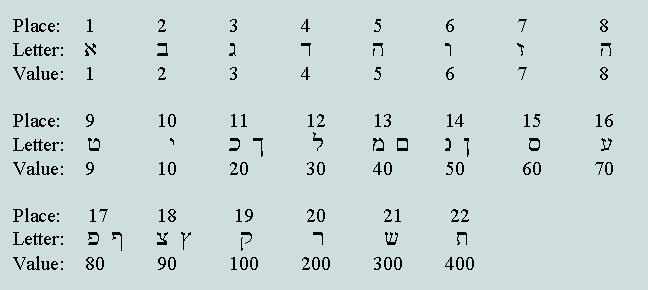
The
practice that existed then was to record numbers on an additive
basis, i.e. the value represented by a string of letters was
simply the sum of the tabular values assigned to each. The characteristic
value (CV) of a conventional Hebrew word, name, or phrase, is
obtained in this manner. As an illustration of the procedure, the
characteristic value of the name SIMEON is derived below.
We observe that all Hebrew reading proceeds from right to left. 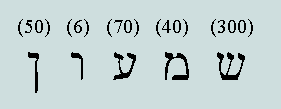
Thus, CV (SIMEON) = 50 + 6 + 70 + 40 + 300 = 466
The Greek alphabet is an ordered set of 24 upper/lowercase pairs of characters. The position and numerical value of each letter of each of these pairs is detailed below:
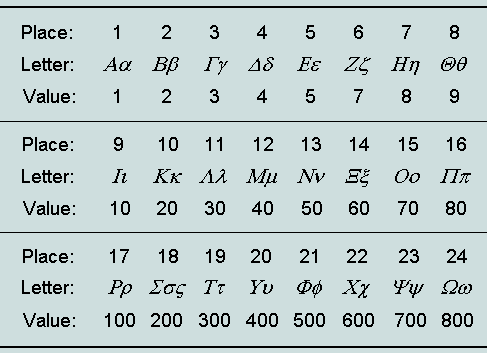
This scheme was introduced circa 600 BC for the purpose of recording numbers on an additive basis, the missing values, 6 and 90, being represented by non-alphabetic symbols. Thus, every string of letters was potentially a number - interpreted by summing the tabular values of the letters.
As a unique example of this procedure, the characteristic values (CVs) of the Lord's Name and Title are evaluated below:
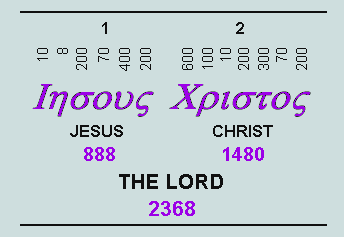
Observe that the letter values appear above and their respective sums below.